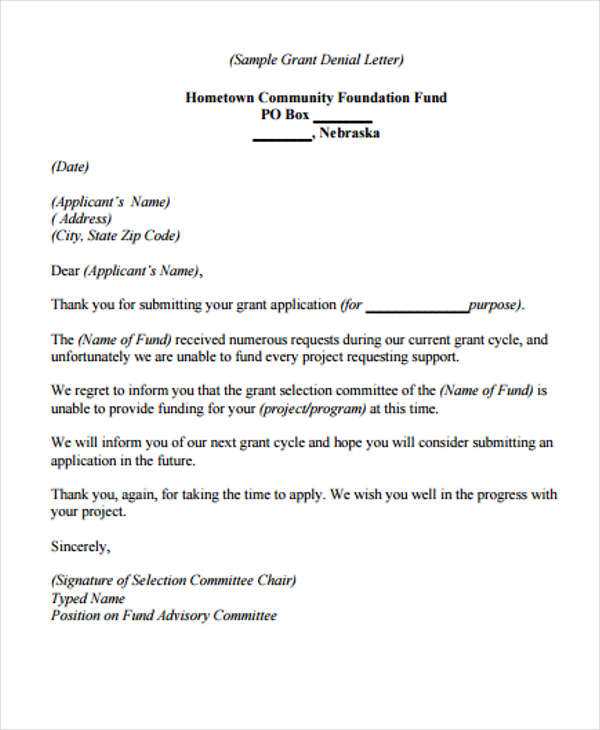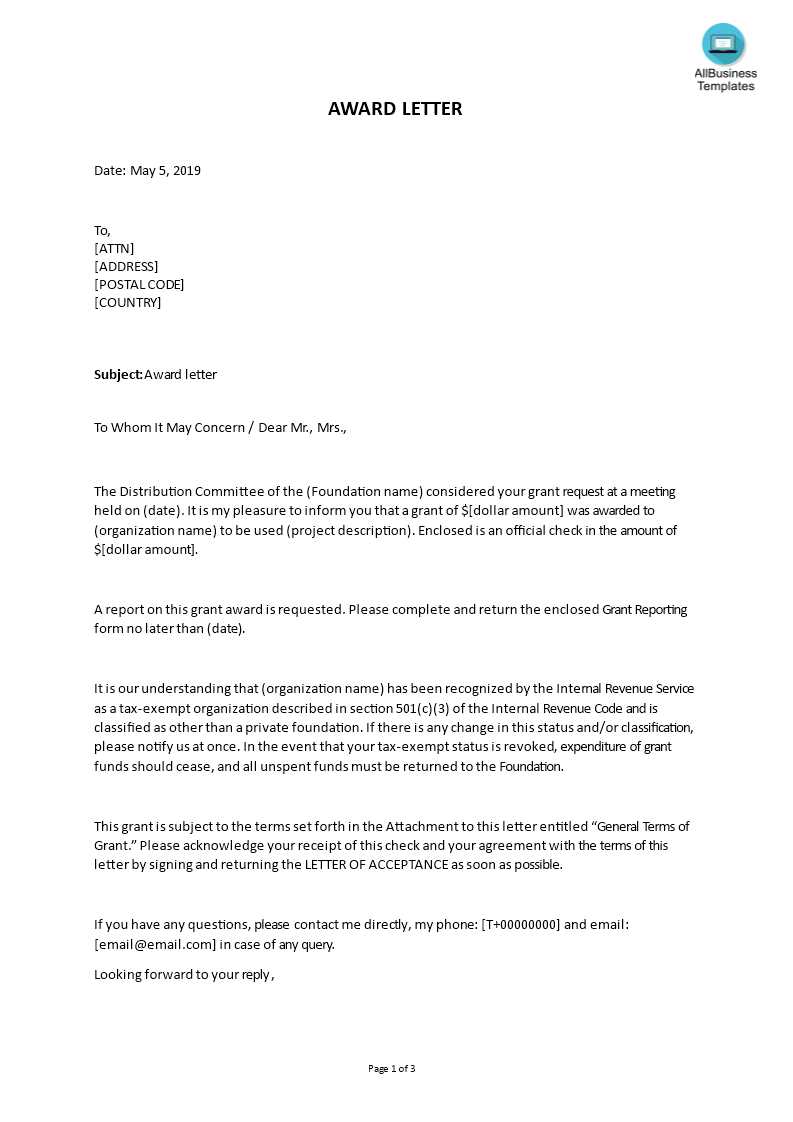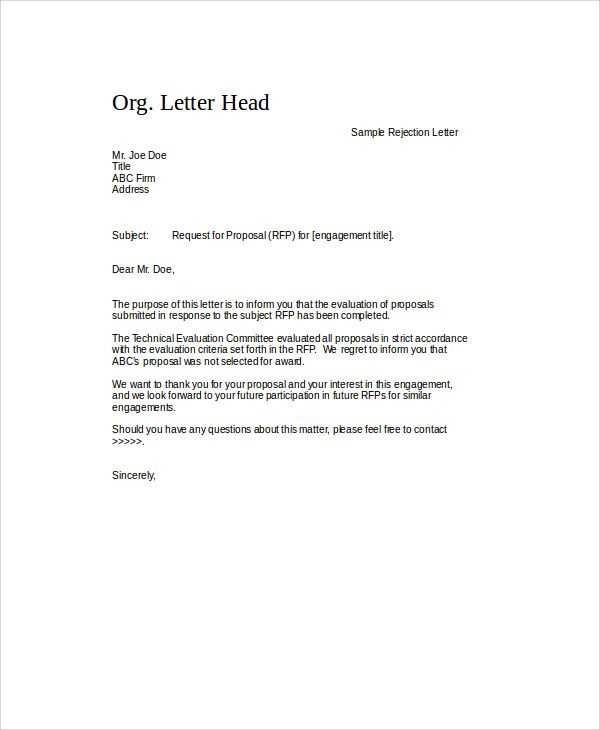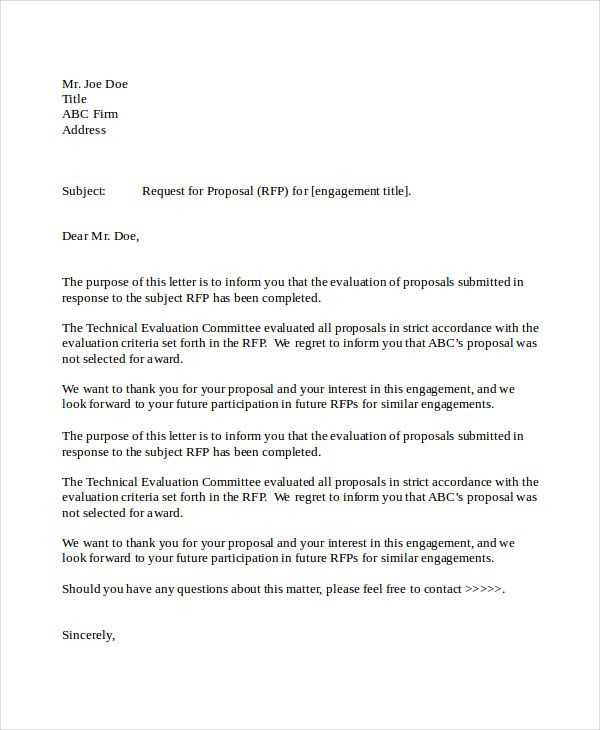RFP Rejection Letter Template for Professional Proposal Responses

In the business world, it is inevitable to turn down certain offers and ideas. Communicating these decisions clearly and professionally is essential to maintaining respect and understanding with potential partners. The ability to politely reject a proposal while preserving a positive relationship is a crucial skill for businesses of all sizes.
When you need to decline a submission, crafting a well-structured response can make all the difference. A clear and courteous message not only explains your decision but also leaves the door open for future opportunities. A professional approach ensures that both parties walk away from the situation with dignity, without misunderstandings or negative feelings.
Understanding how to handle this delicate task can improve your reputation and strengthen long-term business connections. By addressing the key points and being transparent in your reasoning, you convey respect and professionalism. With the right tone, your refusal doesn’t have to be a setback, but rather a chance to build stronger partnerships moving forward.
Why Clear Communication Matters
In any professional setting, it is important to manage expectations and communicate decisions effectively. When a business opts not to move forward with an offer, conveying this message in a polite, clear, and respectful manner is essential. This type of correspondence serves as an official acknowledgment of the decision, providing transparency to the other party while preserving the relationship for possible future collaboration.
What to Include in a Professional Response
A well-constructed message should address several key elements, ensuring that the communication is both informative and tactful. The aim is not only to explain the decision but also to express appreciation for the effort involved. A few critical points to consider when crafting a response include:
| Key Element | Description |
|---|---|
| Clear Reasoning | Explain why the decision was made in a concise and respectful way. |
| Appreciation | Show gratitude for the proposal and the time invested. |
| Future Opportunities | Indicate the potential for future collaboration, if applicable. |
Importance of Tone and Language
The tone of the communication plays a significant role in maintaining professionalism. A positive, neutral tone helps mitigate any negative feelings the other party might experience. It’s also essential to avoid overly blunt or harsh wording that could damage professional relationships. By being considerate and constructive, you foster an environment of mutual respect, which is critical for building lasting business connections.
Why Rejections Are Important in Business
Declining proposals is an inevitable part of the business world, and how these decisions are communicated can have a lasting impact on a company’s reputation. While turning down an offer may seem negative at first, it plays a crucial role in maintaining focus on the company’s strategic goals and objectives. It ensures that only the most suitable opportunities are pursued, allowing resources to be used effectively.
Moreover, clear and respectful communication of these decisions helps maintain professional relationships. Businesses that handle rejections well are seen as more trustworthy and transparent, which fosters long-term partnerships. A thoughtful refusal can also serve as an opportunity to build goodwill by encouraging future collaboration or offering constructive feedback.
Key Elements of a Professional Response
When informing someone of a decision to not proceed with their proposal, certain elements must be included to ensure the message is delivered respectfully and professionally. A well-crafted communication conveys clarity, gratitude, and an open door for future opportunities. Incorporating the right components ensures the message serves its purpose while preserving relationships.
Key points to include are:
- Clear and concise reason: Briefly explain why the proposal isn’t being accepted, making sure to stay respectful and objective.
- Appreciation: Acknowledge the time and effort that went into the submission. Express gratitude for the opportunity to review it.
- Future possibilities: If appropriate, mention that there may be other chances for collaboration or suggest staying in touch for future projects.
- Professional tone: Use polite, neutral language to avoid sounding harsh or dismissive.
- Offer feedback: If relevant, provide constructive feedback that can help the other party improve or understand the decision.
By addressing these components, a professional response not only ensures transparency but also maintains the integrity of the business relationship, making future interactions smoother and more productive.
How to Craft a Clear Reply
When you need to inform someone that their proposal will not be pursued, it’s essential to communicate the decision in a way that is both transparent and respectful. A clear response not only provides the necessary information but also maintains goodwill between both parties. A well-written reply ensures that misunderstandings are minimized, and future collaboration remains possible.
Structure of a Clear Response

The key to an effective response lies in its structure. Start with a polite introduction acknowledging the proposal and expressing gratitude for the effort. Then, offer a brief explanation of the decision, focusing on clarity without excessive detail. Finally, end the communication on a positive note, leaving room for future opportunities or engagement.
Tips for Crafting Your Reply

- Be direct but polite: State the decision early to avoid confusion, but do so in a considerate manner.
- Provide a simple explanation: Offer a brief, objective reason for the decision, without going into unnecessary detail.
- Use professional language: Avoid negative or harsh words. Keep the tone neutral and respectful.
- Maintain openness for future interactions: End the message by expressing a desire to remain in touch or consider future proposals.
By following these steps, you can ensure that your response is clear, concise, and preserves positive professional relationships.
Common Mistakes to Avoid in Responses
When communicating a decision to not move forward with a proposal, it’s easy to make errors that can damage professional relationships. Avoiding these mistakes is key to ensuring that the message is both respectful and clear, preserving a positive atmosphere for future interactions. A few common pitfalls can easily be avoided with careful attention to tone, clarity, and content.
Overly Harsh Language
One of the biggest mistakes in crafting a response is using harsh or dismissive language. Even when declining a proposal, the message should remain neutral and courteous. Negative language can alienate the recipient and create unnecessary tension. Always ensure the tone is professional and considerate, even if the proposal isn’t suitable.
Vagueness and Lack of Detail
While it’s important not to overwhelm the recipient with too much detail, being overly vague can lead to confusion or misunderstandings. A response should provide a clear, concise reason for the decision. Not explaining the rationale at all can leave the other party uncertain about where they stand, which could affect future communications.
By avoiding these mistakes, you ensure that your decision is communicated professionally, with respect for the effort that went into the proposal and with a focus on maintaining a positive business relationship moving forward.
Maintaining Professional Relationships After Rejection
Turning down an offer or idea doesn’t have to result in the end of a professional relationship. In fact, how you handle these situations can significantly impact future collaborations and trust between parties. It’s essential to approach these moments with tact and respect to ensure that both sides maintain a positive outlook for potential future opportunities.
One of the most important aspects of managing these interactions is communication. When delivering a decision, ensure that the tone is respectful and considerate. Even if the proposal is not suitable, recognizing the effort and time spent on it can help preserve goodwill.
Future Collaboration: After declining an offer, express your openness to future proposals or cooperation. This reassures the other party that their work is still valued, even if this particular opportunity didn’t align with current needs.
Follow-up: Occasionally checking in or offering feedback, when appropriate, can show your commitment to the relationship. It’s a simple but effective way to foster mutual respect and trust, paving the way for potential future engagements.
Examples of Effective Responses
Providing a clear, respectful, and professional reply to a proposal is essential for maintaining healthy business relationships. Below are a few examples of how to structure an effective response, ensuring that the decision is communicated politely, with room for future interactions.
Example 1: Simple and Direct Response
Dear [Name],
Thank you for your submission and the time you dedicated to preparing the proposal. After careful review, we have decided to pursue a different direction at this time. We appreciate your effort and hope to have the opportunity to collaborate on future projects.
Best regards,
[Your Name]
Example 2: Offering Constructive Feedback

Dear [Name],
Thank you for submitting your proposal. While we were impressed with the quality of your work, we have decided to move forward with another solution that better aligns with our current needs. One area that we would encourage improvement in is [specific feedback]. We value the time and effort you put into this proposal and would like to stay in touch for potential future opportunities.
Best regards,
[Your Name]
Key Takeaways from Effective Responses:
- Clarity: Be direct yet respectful, making sure the other party understands the decision.
- Gratitude: Acknowledge the effort and time spent on the proposal.
- Future Opportunities: Leave the door open for future collaborations or partnerships.
These examples highlight how to balance professionalism with politeness, offering a clear message while fostering positive future interactions.